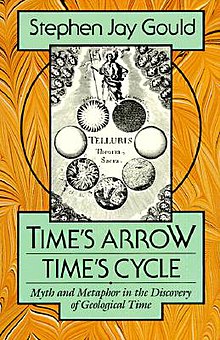Time's Arrow, Time's Cycle

Hardcover edition
|
|
| Author | Stephen Jay Gould |
|---|---|
| Country | United States |
| Language | English |
| Subject | History of geology |
| Publisher | Harvard University Press |
|
Publication date
|
1987 |
| Media type | Print, e-book |
| Pages | 222 pp. |
| ISBN | |
| LC Class | QE508 .G68 1987 |
Time's Arrow, Time's Cycle: Myth and Metaphor in the Discovery of Geological Time is a 1987 history of geology by Stephen Jay Gould offering a historical account of the conceptualization of Deep Time and uniformitarianism using the works of Thomas Burnet, James Hutton, and Charles Lyell.
Gould ranks the development of the concept "deep time," which involved deliberately rejecting the biblical description of earth's past for nearly incomprehensible eons, with the revolutions associated with Copernicus and Darwin. To illustrate this, Gould picked three major figures in the history of geology, one traditional villain (Thomas Burnet) and two traditional heroes (James Hutton and Charles Lyell).
Standard textbook accounts of the achievements of these three figures have long provided what Gould describes as a "self-serving mythology." These flimsy "cardboard" accounts vaunt the superiority of empiricism and inductivism over the scientific nemesis of religious bigotry.
This legend as perpetuated by geology textbooks over the last century claims that geology remained in the service of the Mosaic story of creation so long as armchair geological theorists refused to place fieldwork ahead of scriptural authority. Thomas Burnet was just such an archetypical religious spokesman. A century later, Hutton heroically broke with this biblical zealotry by arguing that geological evidence must rest upon a solid empirical foundation. The Earth's strata, when carefully examined, betray "no vestige of a beginning—no prospect of an end." But Hutton was far ahead of his time. So it was not until Charles Lyell published the Principles of Geology that geologists finally came to accept Hutton's basic message and banished miraculous intervention, catastrophes, and biblical deluges from their science.
Having elaborated this bit of scientific melodrama, Gould proceeds to demolish it by showing that the actualities of Hutton's and Lyell's work were the opposite of the textbook legend. His intention is not simply to debunk the textbook legend, which has already been debunked by historians such as Martin J. S. Rudwick. He sets out to rectify the error and show the real sources of inspiration in the development of deep time which have not been properly understood.
Gould is deeply influenced by Thomas Kuhn's The Structure of Scientific Revolutions. Kuhn argued, in part, that science is a social activity and that theories are intellectual constructions imposed on data, not demanded by them. Along with Kuhn and other philosophers and sociologists of science, Gould has recognized that mental constructs (metaphors, analogies, personal philosophies, imaginative leaps)—not empirical discoveries—are what bring about scientific advance. "Facts" are so embedded in a paradigm that they simply do not have the kind of independent probative power they were once thought to possess.
...
Wikipedia
